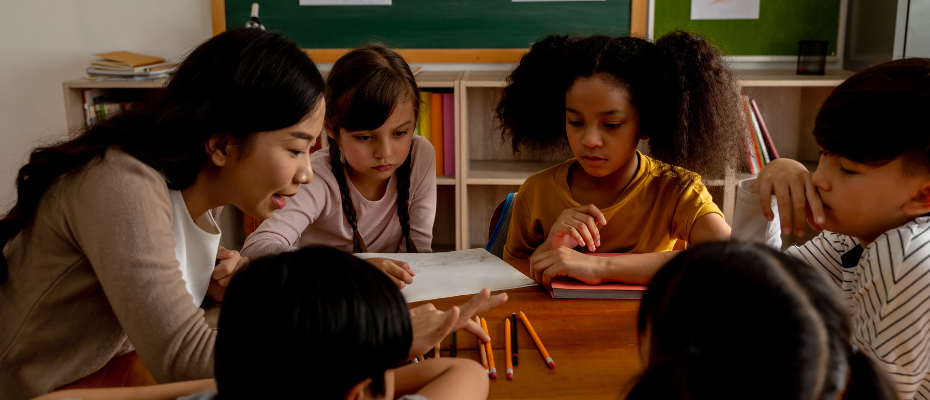What is Differentiated Instruction?

The movement toward inclusion has impacted classrooms by requiring teachers to respond to an extremely broad range of academic and social-emotional needs. In addition to having academically diverse students in their classroom makeup, teachers must also find a way to reach those students who have special needs, English language learners, traditionally disadvantaged students (including those who are trying to bridge the achievement gap, either pre-or post-COVID), those who have experienced trauma, or some combination of any or all these factors. How can this possibly be done? The answer, quite simply, lies in differentiating instruction.
In education, differentiation is a framework for effective teaching that provides students with different ways to learn, regardless of their differences in ability, readiness levels, learning preferences, academic backgrounds, and reading levels. Differentiation is a way for teachers to provide targeted, specific instruction tailored to the unique individual needs of their students. Some students struggle because they have problems with the content. Others struggle due to reading difficulties or learning disabilities. Still, others struggle because the way they prefer to learn doesn’t always “match” the teacher’s, causing a lapse in understanding. Whatever the reason, when this occurs, students begin to lose motivation, causing them to become disengaged in the overall learning process. What these students require is targeted, more individualized assistance so that they can be the most successful student they can be, and the use of differentiation throughout the learning process and curriculum is the key to making this happen.
According to Carol Ann Tomlinson, a leading pioneer in differentiated instruction, teachers can differentiate their instruction in one of four ways: through content, process, product, and learning environment. Let’s explore each of these briefly.
Differentiation through Content
The content is what a student needs to learn. All students need access to the same core content and should be taught the same big ideas and concepts. Access to this content can be adjusted through differentiation. When teachers differentiate by content, the same content or skill is taught to each student. What is different, however, is that the teacher adapts the curriculum so that different students gain access to the skills, knowledge, and understandings differently. When differentiating instruction through content, be sure to include the following strategies.
- Provide texts on tape or other audio means. Students who struggle with the reading process might need to listen to the story multiple times before being able to successfully answer comprehension questions, as an example.
- Some of your students may struggle to write not for lack of imagination or knowledge, but because they haven’t yet mastered the various stages of the writing process. Have some type of scribe system in place (e.g., access to tape recorders, speech-to-text technology, or parent or student helper, etc.) to help those students who struggle to focus on the purpose of the assignment itself rather than its end product.
- Provide multiple opportunities to conference. Struggling students need constant opportunities to check in with the teacher and/or their peers as they continue to work through the task.
- Use a lesson plan based upon the principles of Universal Design for Learning, or UDL. Just as the learning standards can be considered the “what” of teaching, UDL can be considered the “how” of teaching. UDL lessons are designed from the point of view of whole-to-part rather than part-to-whole. There are sections in the lesson plan that target essential (struggling), expected (on target), and enrichment (already have mastered) opportunities that force teachers to incorporate various strategies to help all their students.
Differentiation through Process
This type of differentiation involves the activities that help a student learn. How the material is learned can be differentiated based upon the students’ various learning preferences. Since each student has a preferred way to learn, successful differentiation includes using strategies that deliver the content by matching it to the way that the student likes to learn best, including visual, auditory, kinesthetic, and through the power of words (reading and writing). Differentiating through process also takes into consideration that not all students require the same amount of support from their teachers. As a result, this type of differentiation allows students to work in pairs, small groups, or even individually if that is their preferred method. Doing so allows each student to obtain the most benefit according to his/her preferred way of learning. When differentiating instruction through process, be sure to include the following strategies.
- Provide tiered activities. When assignments and tasks are tiered by complexity, the teacher provides varied tasks that address a student’s level of readiness. Tiering by complexity runs the gamut from introductory levels to less concrete, more abstract ways of thinking.
- Use manipulatives and graphic organizers whenever possible. Some students need concrete solutions to help them engage with the task at hand. Graphic organizers and manipulatives are excellent resources for helping them stay focused, on-task, and motivated.
- Vary the length of time students have in which to work. Time is a precious commodity, and struggling learners most likely find it in short supply. If this is the case, consider allowing additional time for students to work on their more challenging pieces instead of doing activities that they have already mastered.
Differentiation through Product
Differentiation through product refers to student outcomes, meaning what a student can do to show his/her proficiency. Using differentiation, teachers may assign different methods to different students to show proficiency of a concept or idea. When differentiating instruction through product, be sure to include the following strategies.
- Vary the length of the assignment. Allow struggling students to write less. Rest assured — this strategy is not designed to be easier or to place less of a burden on the student. Indeed, teachers need to be mindful to continuously maintain high expectations for all their students, especially for those who read or write less. For instance, instead of requiring all students to complete a five-paragraph essay, consider allowing struggling students to focus on a three-paragraph essay, complete with a solid lead and thesis statement, focused, shorter details, and a conclusion that adeptly summarizes what was written. In this way, students who struggle will still learn using the overall writing process, but their product is much more targeted and focused.
- Use different rubrics to assess skill levels. Naturally, you cannot assess all your students equally if some of them end up with a different finished product. When using a rubric, be sure to target the specific skill(s) so that all students are held to the same quality standard, just not the same quantity standard.
- Use different rubrics to assess skill levels. Naturally, you cannot assess all your students equally if some of them end up with a different finished product. When using a rubric, be sure to target the specific skill(s) so that all students are held to the same quality standard, just not the same quantity standard.
- Allow for both individual and group work. Struggling students need good role models. These groups can be assigned by the teacher with a specific purpose in mind, or the students can work together according to their specific interests. Differentiating instruction through product provides the motivation that students need to stay engaged. A word of caution: teachers need to provide many opportunities for their struggling students to also work independently because if they don’t, students run the risk of becoming too dependent on their peers for assistance.
Differentiation through Environment
This type of differentiation refers to how a classroom is set up to help a student be successful. Optimal learning takes place when a student’s classroom environment matches his/her learning preferences. This includes the physical layout of the room, the way the space is used, various environmental factors, and the overall classroom atmosphere (how the teacher interacts with his/her students as well as how the students interact among themselves). When differentiating instruction through the learning environment, be sure to include the following strategies.
- Include places to collaborate as well as places for individual work. Your classroom should ideally have different furniture arrangements for group, individual, and whole-class learning. The classroom desks should also be divided into groups so that students (struggling and otherwise) can move about the classroom to collaborate with their peers.
- Be aware that seating arrangements play an active role in learning. The key to creating a successful learning environment for all your students is to get and keep students engaged in their own learning. Naturally, many (if not most) of your students are going to want to sit next to their friends. However, it is important to remember that learning is not a spectator sport, and all students must take an active role in their learning.
- Ensure processes are in place to set and maintain routines. Whatever arrangement you decide works best for your class, be sure to set clear guidelines for both group and individual work. You must set and maintain clear classroom expectations, and processes must be established to follow when something (or someone) veers off course.
To learn more about differentiated instruction, visit the Professional Development Institute (PDI) website or our Differentiated Instruction: One Size Does Not Fit All (Grades K-6) course. For over 27 years, PDI has provided high-quality online professional development courses to K-12 educators worldwide. Our courses are designed to offer practical strategies that can be implemented in classrooms immediately while focusing on the most relevant topics in education. All our courses are instructor-led and conducted entirely online at the graduate level. University credit is also available through the University of California Division of Extended Studies. We offer an extensive catalog of online courses that cover the most critical topics in today's classrooms and are affordable for teachers.

View PDI's Catalog of Courses
Check out a list of all PDI graduate-level online courses or sort by grade level or subject area.

Register Now!
Quick access to register for PDI's online courses using our secure system.

Learn More about PDI
Find out how to reach PDI and get answers to any questions you may have.
